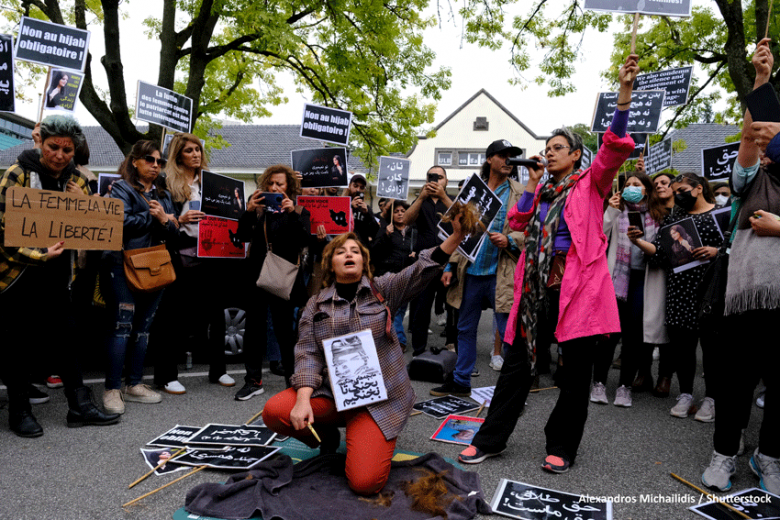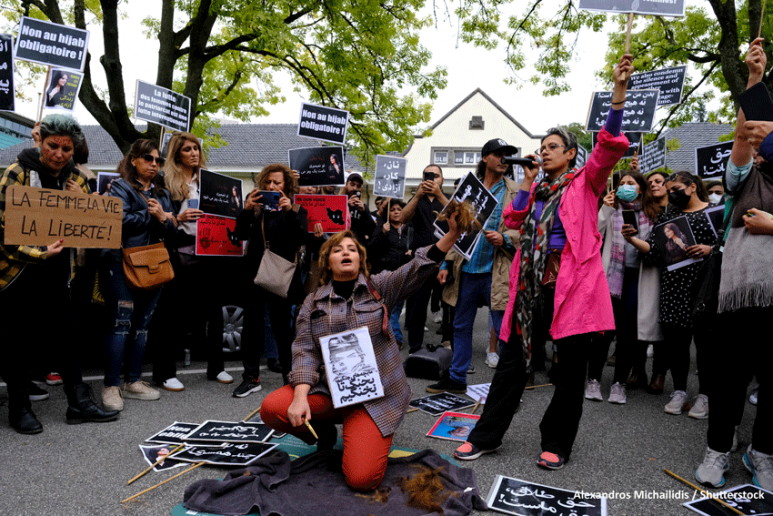By Sarra Riahi
Mahsa Amini, a 22 years old Kurdish Iranian woman has died after being arrested and beaten by the Iranian morality police for ‘improper hijab’. Her death fostered the people’s long discontent with the oppressive Islamic Republic of Iran. Far from the promise of the revolution, that of freedom and social justice, the Iranian regime imposes repressive regulations over women’s bodies. A wave of protests spurred, where Iranian women, men and particularly the youth, burned hijabs, symbols of the state’s power over its citizens. The Iranian women demand freedom, over their lives and over their bodies.
In Europe, those protests against the regime have often been framed as a rejection of Islam or the hijab. A mediatic and political framing that does not bode well for Muslim women on the European continent.

For Fatma Torkhani, French journalist, the political instrumentalisation of social or political contentious to advance racist discourses is an expected phenomenon:
“When you live in France, as soon as something happens about the hijab, terrorists attacks or something else, we know we’re going to take a punch, we know it’s going to be utilised. This situation is moving, they are fighting for their freedom, for their rights. The veil in Iran is that of political oppression and dictatorship. In Europe, the treatment of information very quickly shifts to something else. It is very specific to a way of doing journalism in France. We do not detach ourselves from a centred and Franco-French European perspective,” she tells Media Diversity Institute.
A Eurocentric lens shapes the treatment of international news in the European media. There is Europe, the bearer of civilisation and women’s rights, and the others. Through the Eurocentric and racist worldview, Iran equals Islam which equals all Muslims worldwide. Such a Eurocentric gaze, which bathes in deep-rooted racism, is also inside the newsroom.
Studies have shown that newsrooms are predominantly white and masculine spaces. According to Belgian journalist Sarra El Massaoudi, racialised individuals such as Muslim women are a little segment of the editorial staff. This lack of representation of minority groups “contributes to not questioning many journalistic practices”, she adds, “oftentimes racism and sexism are minimised in newsrooms. They are not seen as something structural in the industry. So it is not uncommon that when a racialised journalist highlights an instance of racism, it is regarded as an interpersonal matter.”.
As such, Eurocentrism produces figures of otherness within the newsroom and in its journalistic productions.
The death of Mahsa Amini and the following protests have made the cover of many newspapers. However, background information on women’s fight for freedom in Iran is scarce, and so is context on the social, political, and economic causes that explain the growing discontent of the Iranian people over the years.

The media framing is often that of Iranian women against Islam, or Iranian women against the hijab. “There is, in this media coverage, a dehumanisation at work, as well as a latent orientalism“, says Sarra El Massaoudi. “Through such a gaze, it’s the same whether you are in Iran, Maghreb, or Western Europe”.
For Fatma Torkhani too, context is key in journalism. Yet orientalism and Islamophobia deprive the other of any complexity and individuality.
“In France, there is no desire to make the difference between a veil in India, North Africa, France, and Iran. However, sociologically there are differences. The way of practicing religion differs according to the context. In Tunisia during the revolution under Ben Ali, women wore the veil as a political sign of opposition to the Ben Ali regime. So we can see through history, context matters,” Torkhani says.
The Iranian context is unique and deserves due attention from those who seek to understand and support Iranian women in their fight. For Manal, Belgian founder of soeur.muz, a platform run by and for Muslim women, Iranian and Muslim women alike are often denied agency.
“Iranian women are agents of change in their country – and have been for many years. The West must leave its paternalism behind,” she tells Media Diversity Institute.
By framing the Iranian protests as fights against Islam and/or the hijab, European media discourse has compared the Iranian protesters to Muslim women in Europe who defend their rights to wear the hijab.. For Manal, both a drive and a consequence of such coverage is exactly to delegitimise Muslim women fight for their body autonomy and against Islamophobic and controling policies. Such coverage she says “makes us feel guilty in our fight. It is telling us that it’s not fair that we fight”. This opposition is a blatant fallacy:
“They put two fights in opposition when it’s the same, we have the same target, the patriarchy and the control of our bodies,” she tells Media Diversity Institute.
According to Fatma Torkani, denying agency and neglecting the historical and political context of the Iranian protests spurs from a colonial mentality. From a colonial and Eurocentric point of view, the other is a homogeneous, governable and governed whole.
“This is a colonial fantasy. Europeans would like everyone to look like them, to live like them, as they consider having the best way of life. In that context, to uncover one’s body is a sign of civilisation. This is symptomatic of the deep sense of superiority of Latin Europeans,” Torkhani recalls.
En France, certaines manifestent pour aller à la piscine en #burkini. Hommage aux merveilleuses Iraniennes qui osent s’affranchir de la dictature islamiste.
La liberté des femmes est incompatible avec le #voile !#Iran https://t.co/WTv8BfOrSm— Julien ODOUL (@JulienOdoul) September 20, 2022
[“In France, some protest to go to the swimming pool in #burkini. Tribute to the wonderful Iranian women who dare to free themselves from the Islamist dictatorship. Women’s freedom is incompatible with the #veil!” Julien Odoul, extreme right wing politician (Rassemblement National).]
Feminism is used as a banner and hides Islamophobia and racism. This is femonationalism, the use of feminism and women’s rights in the pursuit of xenophobic and nationalist agendas. In the coverage of Iranian women burning the hijab, a strong symbol of their oppression, this case is taken as proof that the veil should be banned in Europe. Under the guise of feminism, what is considered an issue in European countries, the veil/Islam, shapes the media treatment of the protests in Iran. Sarra El Massaoudi explains that,
“Under the pretext of being a feminist you [as a journalist or politician] are violent towards women, you instrumentalise a real pain, a material reality for women in Iran, for you here to brutalise women who wear a headscarf, and therefore the whole community in Europe. Because that’s it too, that is to say, men, fathers, husbands, brothers, they are violent, purely patriarchal, because they are Muslims”.
Such coverage has consequences. It stigmatises a part of the population, with on the first line of sight, women wearing the veil. Fatma Torkhani explains that,
“European, French, and Muslim, women who wear a headscarf are excluded from education, work, housing, and are victims of increasing attacks. Because they are women, they also suffer from sexism, street harassment, and violence. We rarely deal with these subjects. Rather we use international news to best target the internal other.”
Far-right dog-whistles are taken up across the political spectrum and media landscape. It normalises and grants legitimacy to far-right rhetoric. Therefore Sarra El Massaoudi explains, “the audience is fed with racist and sexist ideas without being provided with information, contextualization.”
Such coverage legitimises policing women’s bodies, such as banning the headscarf, for them to be free. Those identified as Muslims and/or foreigners are stigmatised and excluded from the citizen community. Fatma Torkani explains “Some leave for what they consider to be more tolerant countries. For those who do not have the means, it is a withdrawal. Minority groups are left on the margins of society. Isolated, they suffer from economic discrimination, precarity, and increasingly strong violence.”
Such media treatment, Fatma argues “feeds a mistrust, a distrust for the media, while the press is supposed to be a counter-power and the fourth column of democracy”.
The role of the media in bringing information of public interest to their audience is crucial. For Sarra El Massaoudi, part of the answer is in the newsrooms: “the editorial staff needs to be more inclusive. As long as it remains a realm dominated by white males from a certain social class, it will not work”. When the newsrooms change certain practices and concepts can be rethought. Sarra explains that “journalists must stop thinking that neutrality and objectivity means holding out the microphone to everyone,” she adds, “there is a journalistic duty in terms of quality, ethics, so sometimes saying ‘no this is racist, it’s sexist, not of general interest’, is necessary to prevent certain notions from being considered as information when it is just violence.”
For Manal a lack of contextualisation is part of the dehumanisation of Muslim women, who are often excluded from participating in the media space. “We must be able to contextualise, here we must take the time to do so, to place the story in its historical and political context, and interview relevant people” says Sarra El Massaoudi.
To Fatma Torkhani, the European media must detach itself from Eurocentrism and moral judgment: “it is very European to erect principles which are supposed to embody democracy, freedom of expression etc. As if we held a monopoly over the principles of freedom.”
“We must stop with groundless and misleading parallels. Rather we should get out of France, try and understand the Iranian context. We must get out of sensationalism, and take an interest in the realities on the ground,” Torkhani argues.
As American-Iranian organiser and writer, Hoda Katebi, puts it there are different stakes and contexts for Muslims living in the West compared to those living in Iran.
Photo Credits: Alexandros Michailidis / Shutterstock

